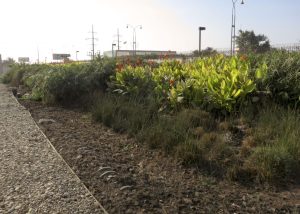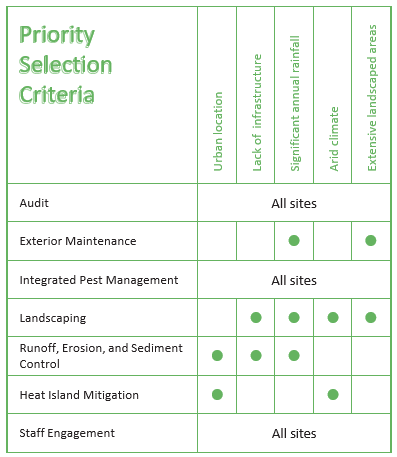Strategy Selection Factors
In order to determine the most appropriate site strategies, Site Green Teams should identify the contexts of the regional habitats in which their embassy compounds are located, and then consider which of the following characteristics are applicable:
- Urban Location: Sites in high density areas are likely to have significantly higher ratios of hardscape to landscape, a situation that tends to generate greater quantities of stormwater runoff and contributes to the heat island effect that impacts the local area and ultimately the greater region.
- Lack of Infrastructure: Sites should routinely implement low-impact development strategies to retain, infiltrate, and treat stormwater on-site. These strategies are particularly important for sites located in developing regions that lack infrastructure to mitigate stormwater.
- Significant Annual Rainfall: Sites located in areas with moderate or heavy annual rainfall should work to integrate pervious surfaces and natural stormwater detention techniques to manage site runoff and reduce erosion. These locations should also consider harvesting rainwater for reuse (see Water: Rainwater Harvesting).
- Arid Climate: In dry climates, sites should undertake landscaping strategies that include drought-tolerant native and adapted plant species to conserve water and support the local ecological environment. Consider opportunities for reducing hardscape, and increase shading to reduce heat islands.
- Extensive Landscaped Areas: Sites that manage an extensive landscaped area, including sites where the facility area is more than twice as large as the building footprint, should explore IPM solutions, examine landscaping practices, and undertake low-impact exterior maintenance. Consider constructed wetlands for tertiary on-site wastewater treatment (WWT) and infilltration opportunities. Also, consider reducing lawn areas to a minimum to reduce irrigation demands.
Sustainable site features include permeable gravel for rainwater absorption, constructed wetlands for on-site biofiltration, native plant species to reduce irrigation requirements, and efficient exterior lighting that minimizes light pollution and conserves energy.



